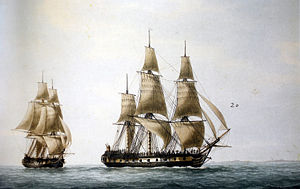 The
Recherche and Espérance, by
François Roux
| |
| History | |
|---|---|
|
| |
| Name | Espérance |
| Namesake | Hope |
| Builder | Toulon |
| Laid down | June 1780 |
| Launched | 14 August 1781 |
| Christened | Durance |
| Commissioned | 30 October 1781 |
| Out of service | 28 October 1794 |
| Reclassified | Frigate in 1791 |
| Fate | Sold for scrap |
| General characteristics | |
| Class and type | Rhône-class scow |
| Displacement | c. 350 tonnes |
| Length | 37 m (121 ft 5 in) |
| Beam | 8.3 m (27 ft 3 in) |
| Draught | 4.2 m (13 ft 9 in) |
| Propulsion | Sail |
| Sail plan | Full-rigged ship |
| Complement | 200 |
| Armament | 6 × 8-pounders + two carronades |
| Armour | Timber |
The Espérance was a Rhône-class scow of the French Navy, launched in 1781 and later reclassified as a frigate. She earned fame as one of the ships of Bruni d'Entrecasteaux's expedition. The Australian town of Esperance and Esperance Bay in Western Australia were named after her. She was sold for breaking up in 1794.
Career
Espérance was built as Durance and served in de Grasse's squadron as a troopship. On 18 December 1782, she departed Toulon with the frigates Précieuse and Prosélyte, and the corvette Poulette, in a convoy bound for the Caribbean, that also included the fluyts Gracieuse and Rhône. [1]
A decade later, on 29 September 1791, Espérance under Captain Huon de Kermadec, and Recherche sailed from Brest to New Caledonia. They were on a mission under the command of Admiral d'Entrecasteaux in search of the explorer Lapérouse. The mission was unsuccessful: it was not until 1826 that the mystery of Laperouse's disappearance was solved.
Fate
On 28 October 1793, Espérance was captured by the Dutch at Surabaya, only to be returned to France in February 1794. She was sold to Holland in September and sold for scrap two months later.
See also
Citations
- ^ Roche, Jean-Michel (2005). Dictionnaire des bâtiments de la flotte de guerre française de Colbert à nos jours. Vol. 1. Group Retozel-Maury Millau. pp. 159, 180. ISBN 978-2-9525917-0-6. OCLC 165892922.
 The
Recherche and Espérance, by
François Roux
| |
| History | |
|---|---|
|
| |
| Name | Espérance |
| Namesake | Hope |
| Builder | Toulon |
| Laid down | June 1780 |
| Launched | 14 August 1781 |
| Christened | Durance |
| Commissioned | 30 October 1781 |
| Out of service | 28 October 1794 |
| Reclassified | Frigate in 1791 |
| Fate | Sold for scrap |
| General characteristics | |
| Class and type | Rhône-class scow |
| Displacement | c. 350 tonnes |
| Length | 37 m (121 ft 5 in) |
| Beam | 8.3 m (27 ft 3 in) |
| Draught | 4.2 m (13 ft 9 in) |
| Propulsion | Sail |
| Sail plan | Full-rigged ship |
| Complement | 200 |
| Armament | 6 × 8-pounders + two carronades |
| Armour | Timber |
The Espérance was a Rhône-class scow of the French Navy, launched in 1781 and later reclassified as a frigate. She earned fame as one of the ships of Bruni d'Entrecasteaux's expedition. The Australian town of Esperance and Esperance Bay in Western Australia were named after her. She was sold for breaking up in 1794.
Career
Espérance was built as Durance and served in de Grasse's squadron as a troopship. On 18 December 1782, she departed Toulon with the frigates Précieuse and Prosélyte, and the corvette Poulette, in a convoy bound for the Caribbean, that also included the fluyts Gracieuse and Rhône. [1]
A decade later, on 29 September 1791, Espérance under Captain Huon de Kermadec, and Recherche sailed from Brest to New Caledonia. They were on a mission under the command of Admiral d'Entrecasteaux in search of the explorer Lapérouse. The mission was unsuccessful: it was not until 1826 that the mystery of Laperouse's disappearance was solved.
Fate
On 28 October 1793, Espérance was captured by the Dutch at Surabaya, only to be returned to France in February 1794. She was sold to Holland in September and sold for scrap two months later.
See also
Citations
- ^ Roche, Jean-Michel (2005). Dictionnaire des bâtiments de la flotte de guerre française de Colbert à nos jours. Vol. 1. Group Retozel-Maury Millau. pp. 159, 180. ISBN 978-2-9525917-0-6. OCLC 165892922.